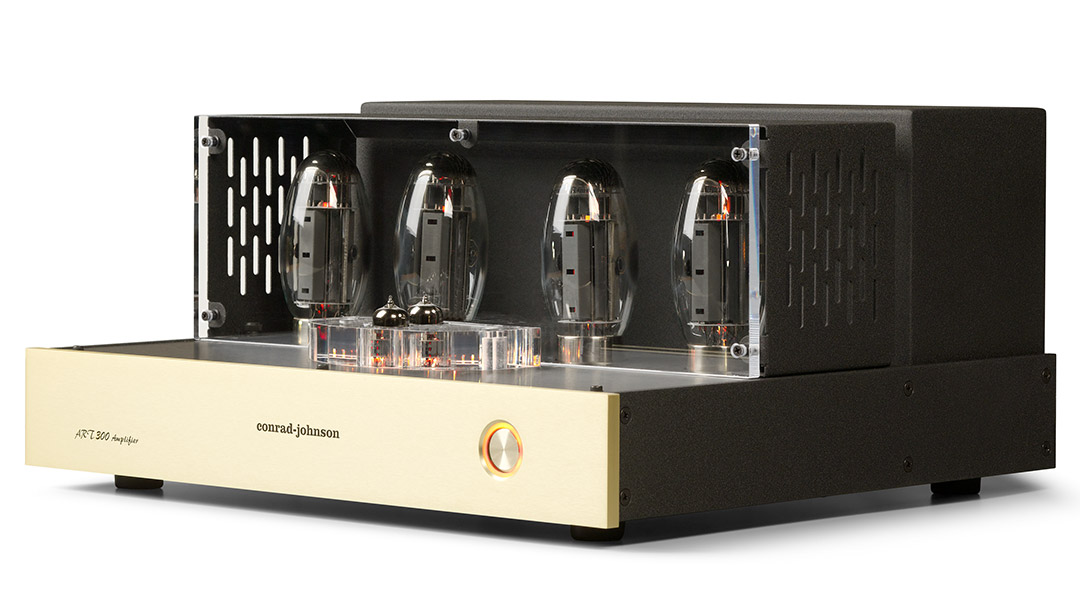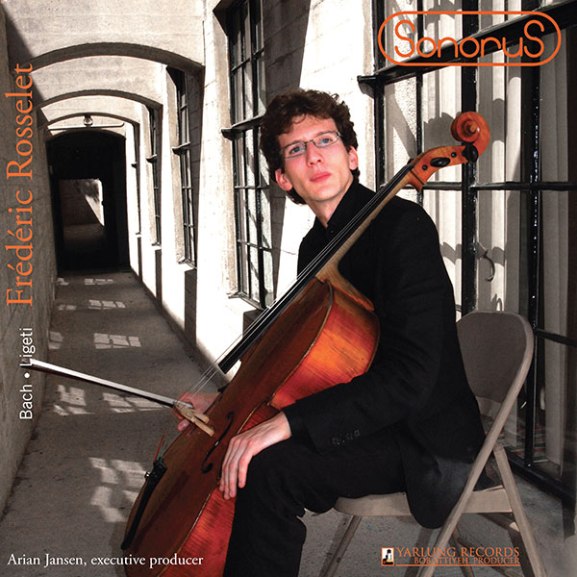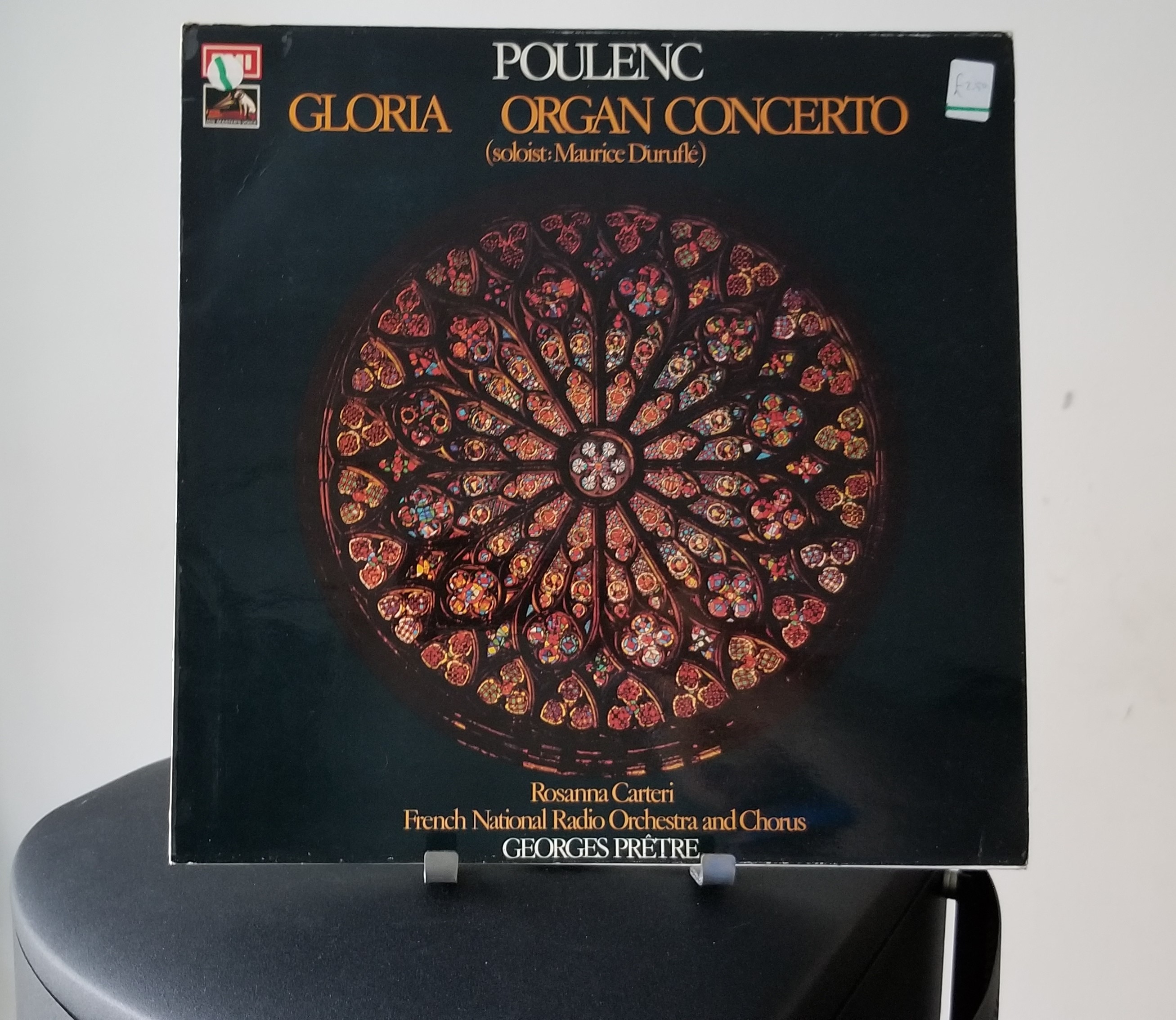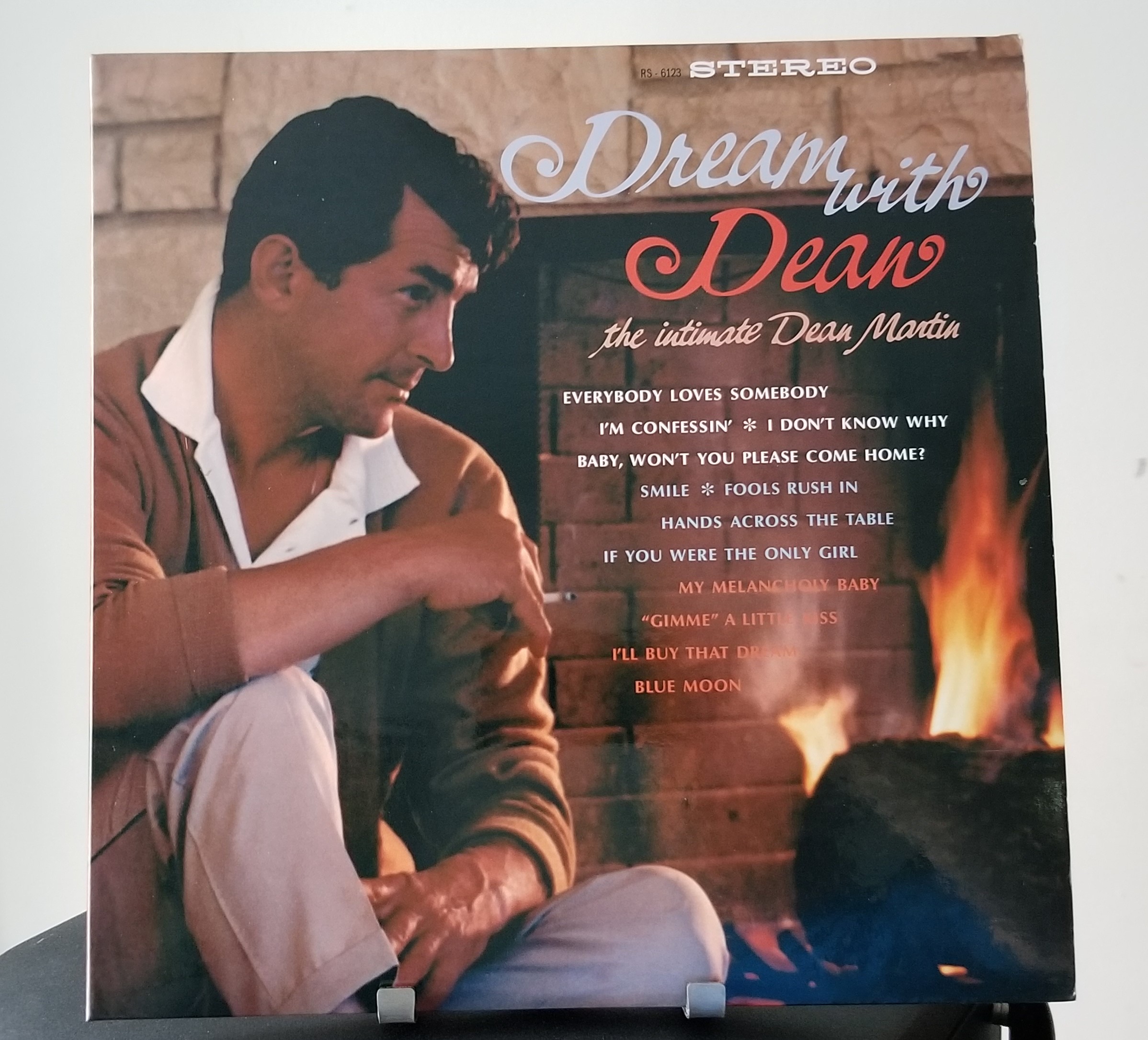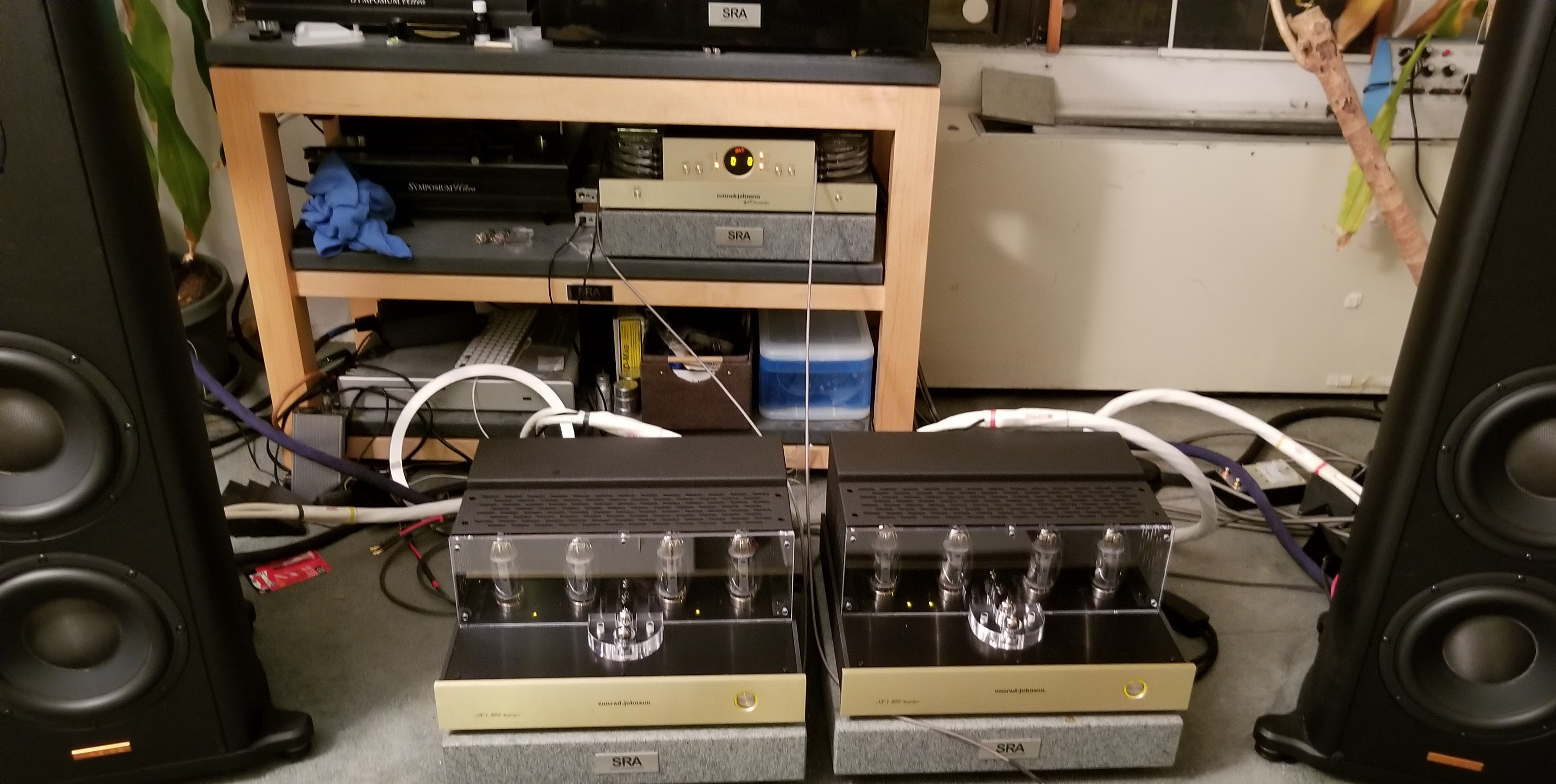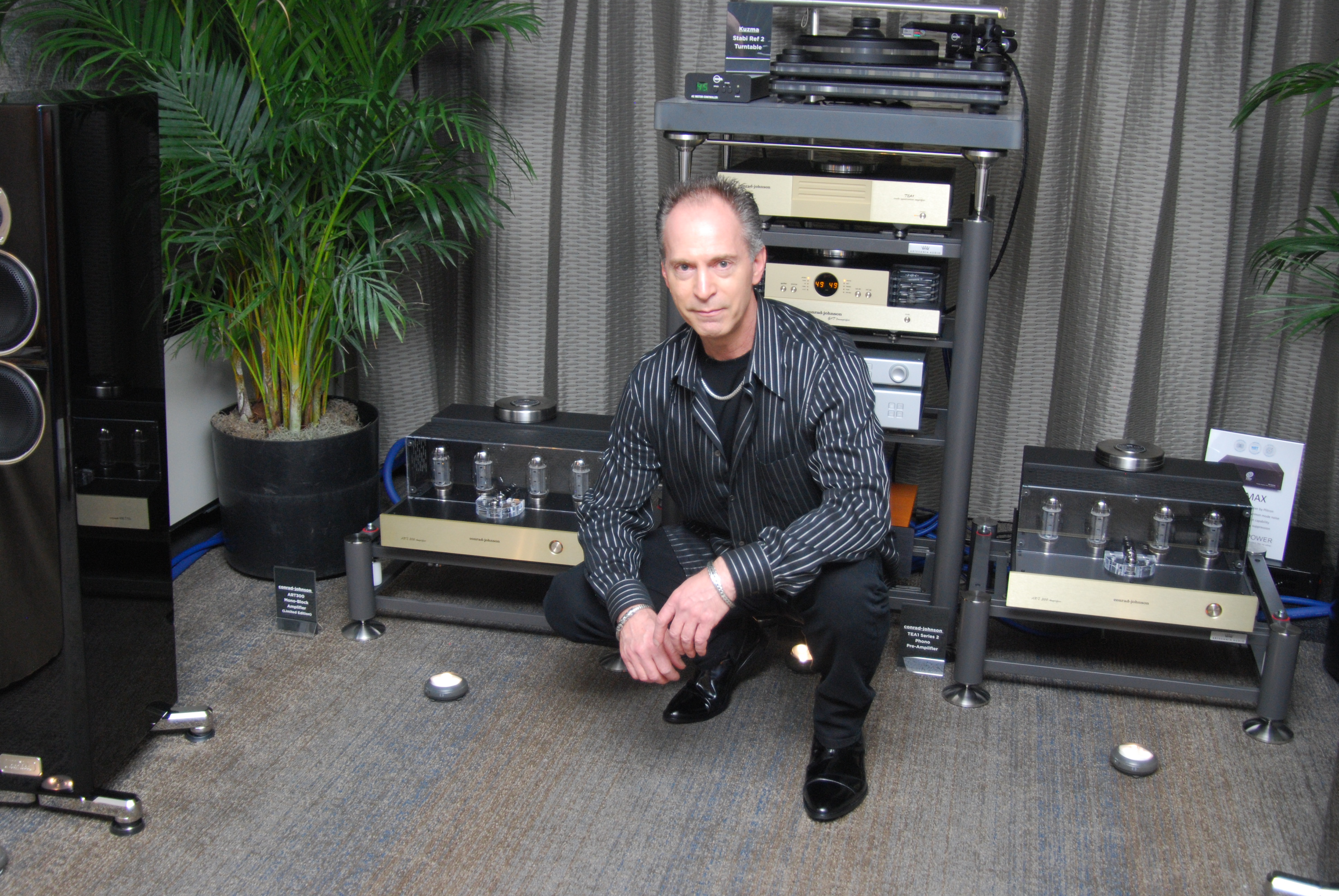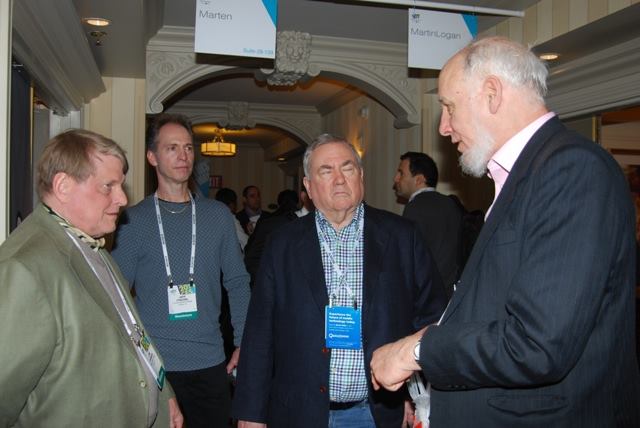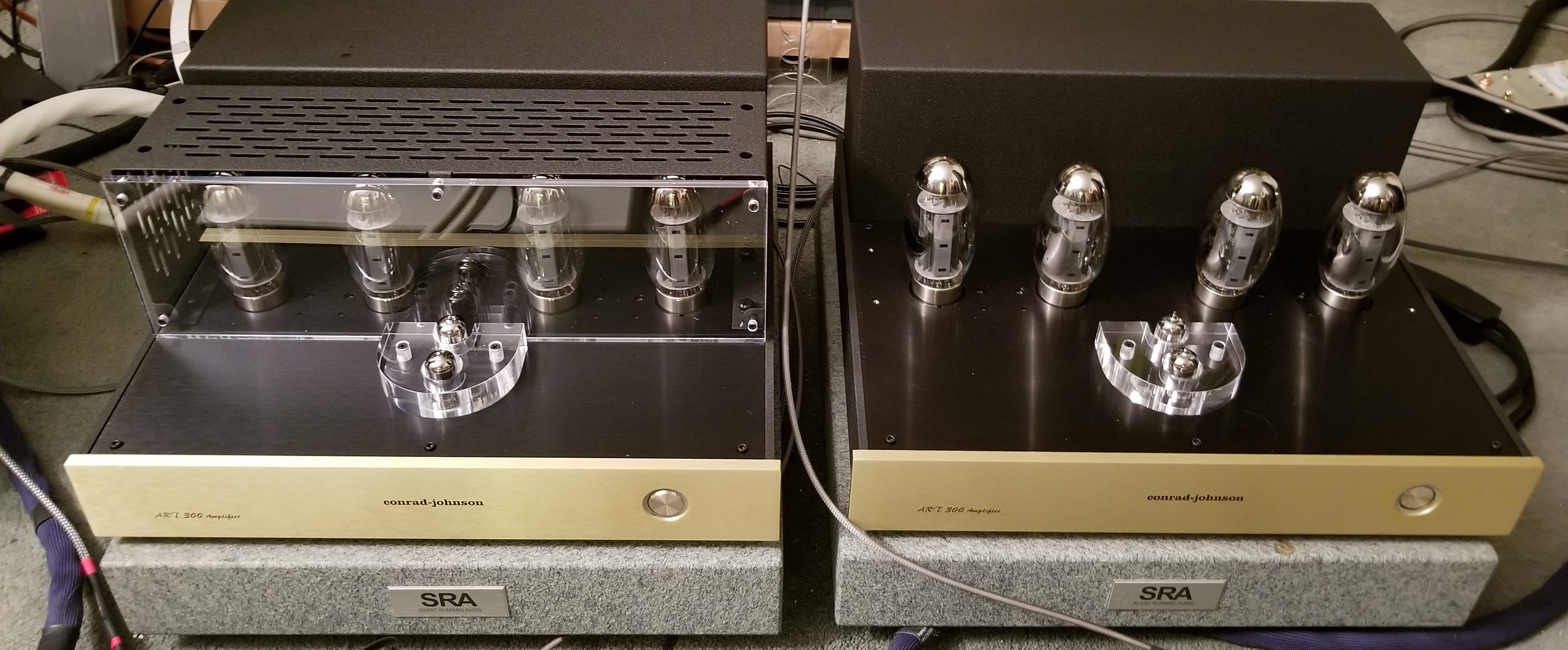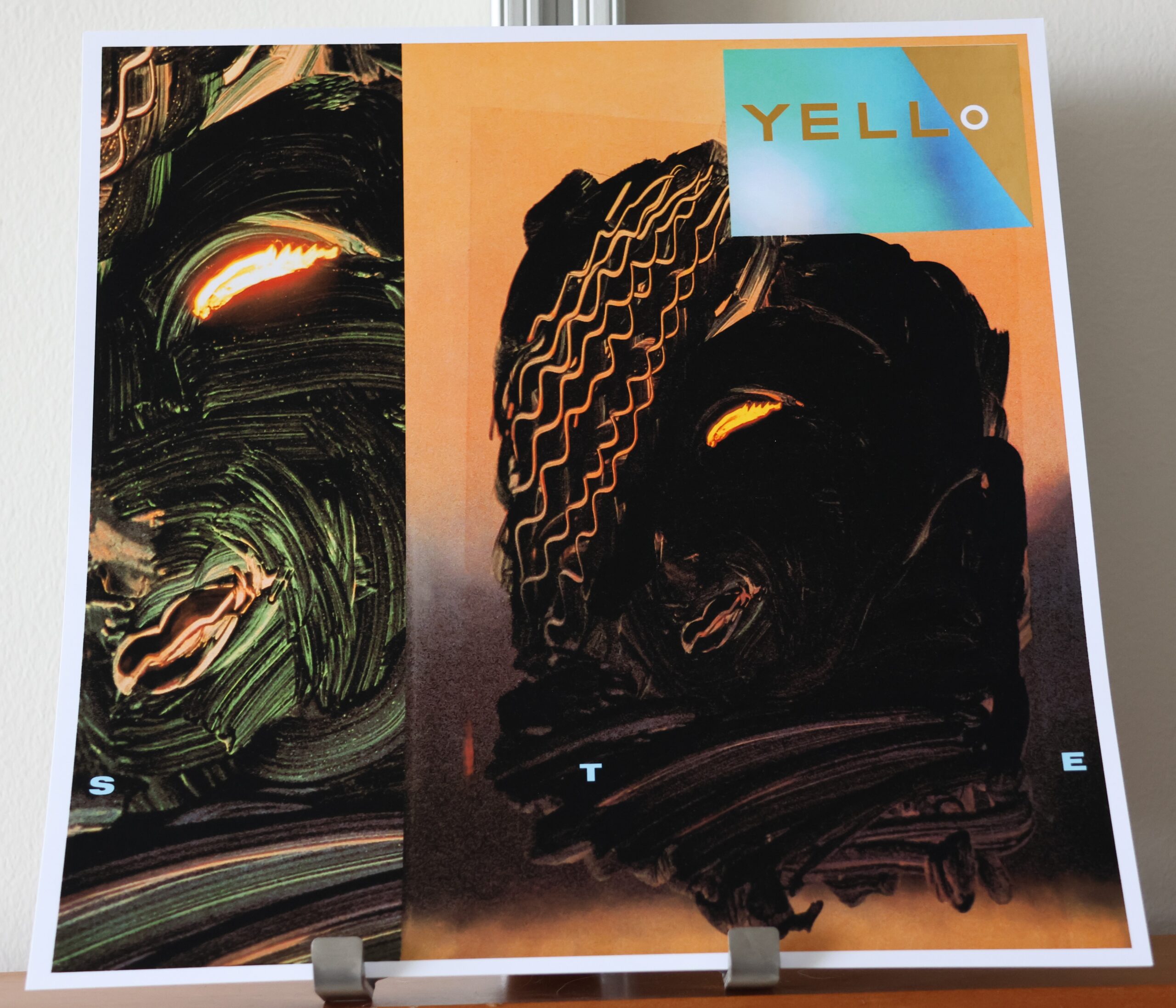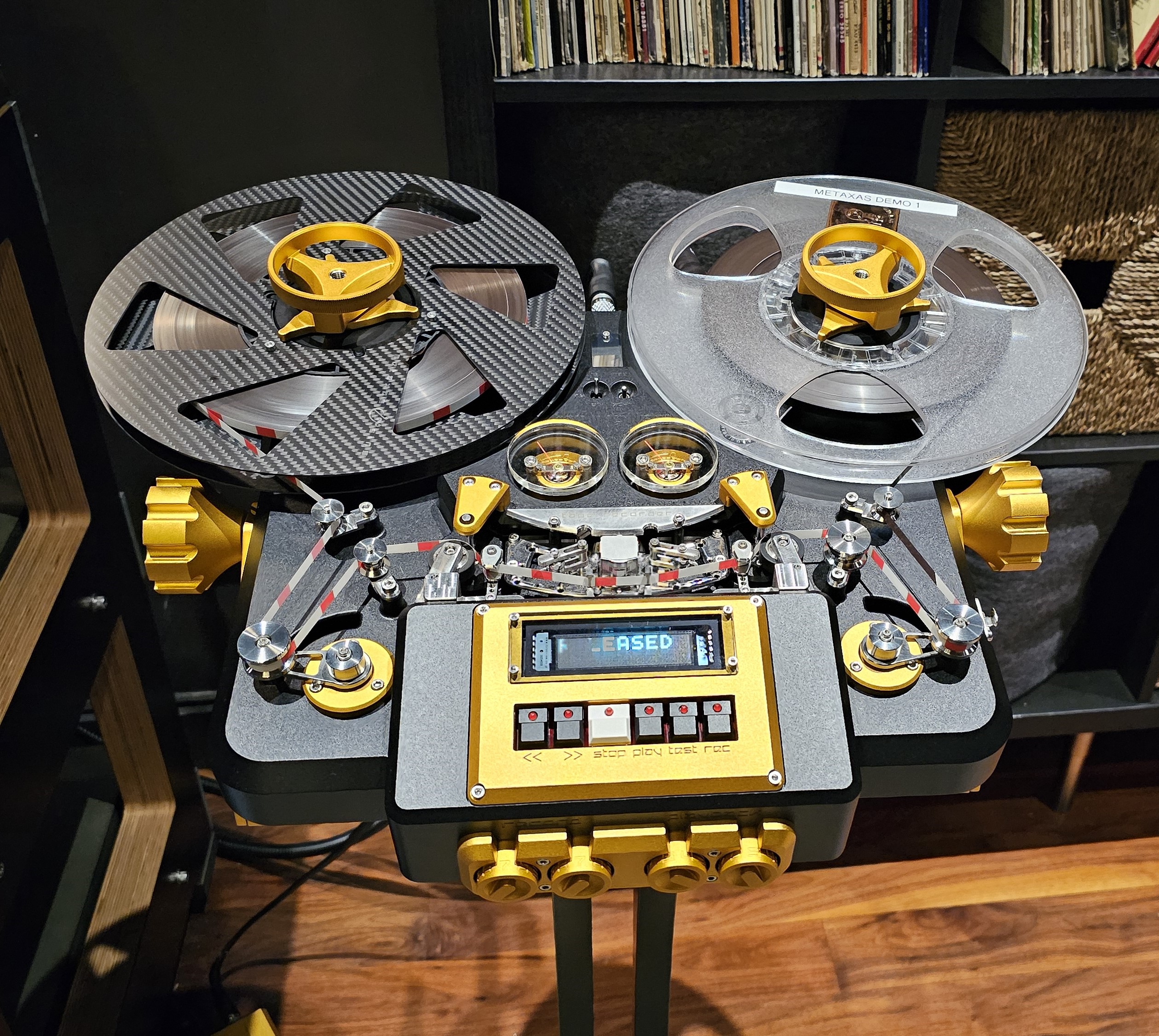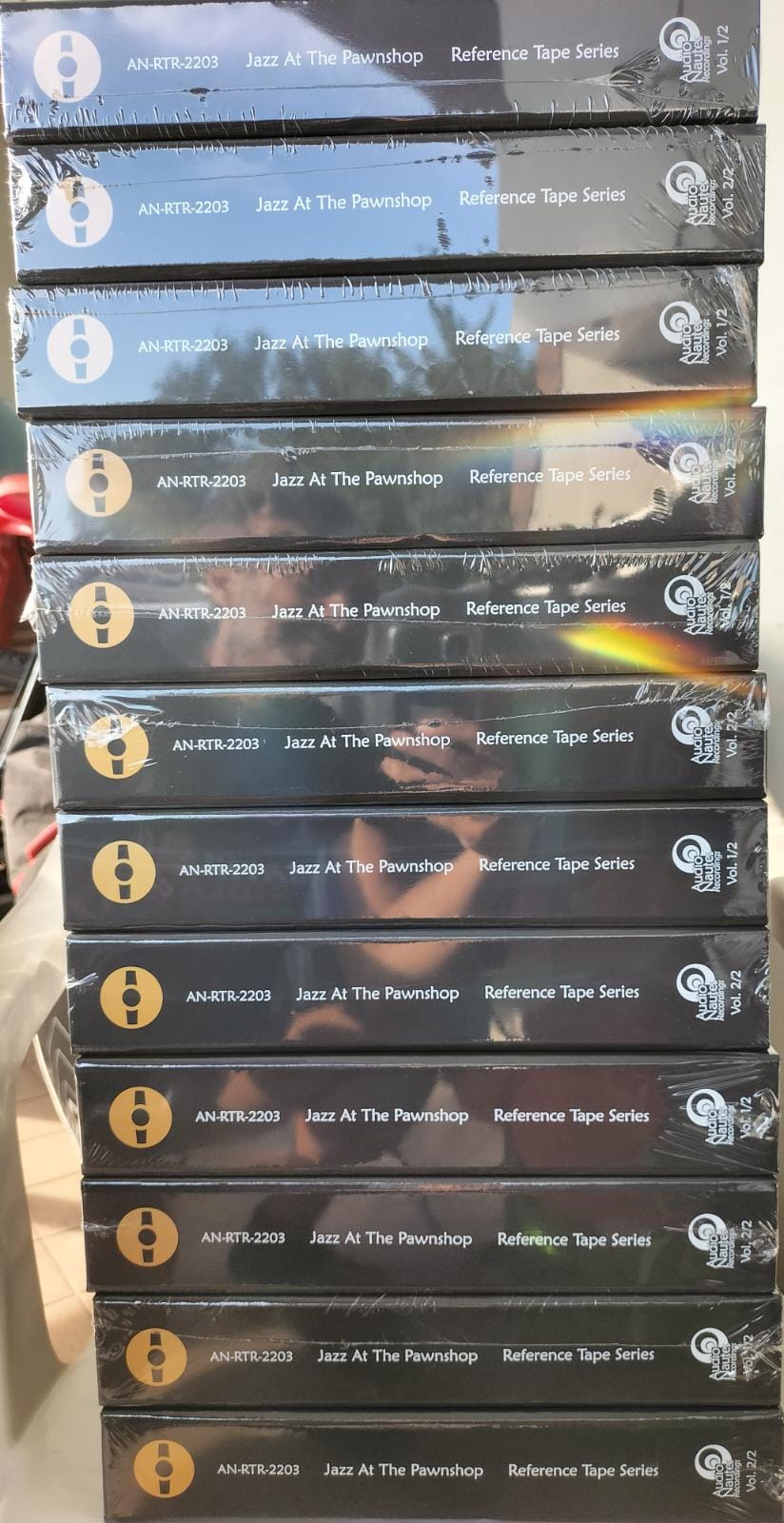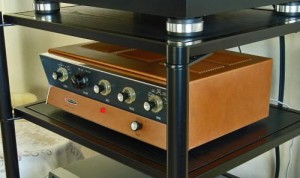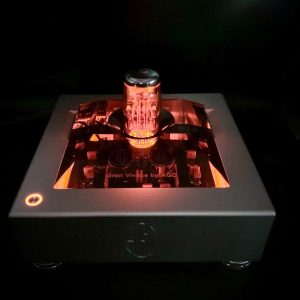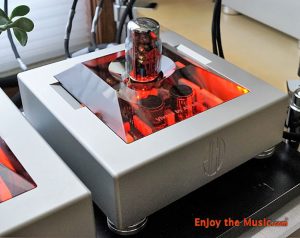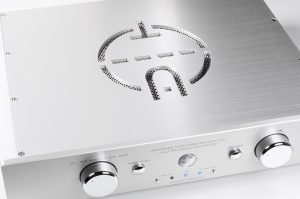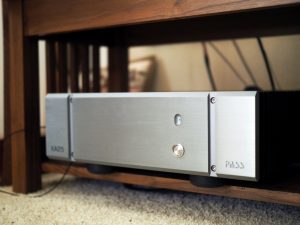When conrad-johnson releases a statement product, everybody listens. Particularly when the new 40th anniversary ART300 amplifiers are the team of Bill Conrad, Jeff Fischel and Lew Johnson's first crack at an amplifier design incorporating the newly designed Tungsol KT-150 output tubes.
Make no mistake. The new 40th Anniversary ART300 monoblock amplifiers aren't the conrad-johnson Premier One amplifier your grandfather father knew. Nor the Premier 8 amplifier your father knew. Not even the original conrad-johnson ART amplifiers that I've grown accustomed to for the past seven or so years. No, these amplifiers are a totally different beast. In some ways, evolutionary (in the sense of conrad-johnson's progression from the ART Series 3 to the GAT preamplifier) and in other ways they're revolutionary (the new Tungsol KT150 output tubes redefine the classic "conrad-johnson" sound). The new ART300s are very, very special amplifiers and as we'll see, set benchmarks for sonic reproduction in several areas. (They make a perfect match, too, with the latest GAT Series 2 preamplifier.)
Who Says You Can't Teach An Old Dog New Tricks?
The ART300s sounded (arriving with 120 hours of playing under their belt) surprisingly good straight out of the box. But there was more—oh, so much more—to come as the amplifiers reached and surpassed that magical 300 hour burn-in mark.
What struck me first about the new ART300 amplifiers was their spooky, solid-state-like quietness and transparency. Ten dB quieter than the original ART amplifier isn't exactly chopped liver and that lowered noise floor brings with it a host of other benefits.
Permit me to digress for a moment. conrad-johnson amplifiers—dating back almost 40 years ago to the original 75 watt per channel MV75—were renowned for their naturalness, dimensionality, soundstaging and sense of space; but they always, however, fell a little short in the transparency department. Or as Harry Pearson observed in those days, tube equipment sounded like you were listening through a dirty pane of glass while solid-state gear obscured the spaces between instruments. Over the years, designers Conrad and Johnson made significant inroads in reducing their equipment's noise floor that culminated in the first ART amplifier and GAT preamplifier. There's, however, simply no contest between the original ART amplifier and Bill, Jeff and Lew's latest effort when it comes to transparency. The new ART300, particularly when paired with Knut Skogrand's Beethoven interconnects and speaker cables along with the new Magico S5 Mk. 2 speakers, offers a clear as day window into the music and soundstage.
There's no better example of the ART300's astonishing transparency than EMI recordings from the Golden Age of Stereo. While EMI strings (especially early EMIs!) aren't quite as natural as some other labels, recordings such as Sir Charles Groves and the LSO performing Grace Williams Concerto for Trumpet and Orchestra (EMI ASD 3006) or Andre Previn and LSO doing Britten's "Passacaglia" from Peter Grimes (ASD 2906) just define ambience and exude sense of the hall. Sure, they're many other high-end audio amplifiers (including the original ART amplifiers) that capture that sense of the recording space. But the ART300s are working on an entirely different plane here. The amplifiers—especially in combination with the Skogrand Beethoven cables—simply lay bare the back and side boundaries of the recording space and reverberation of instruments and voices off these walls. They lay bare the distance between the back of an orchestra or singers and the back wall of the hall or studio. They lay bare the reflections off the walls. They lay bare the solidity of the hall's walls. Take for instance Howard Snell's trumpet on the Grace Williams composition. Never before has it been easier to see in the "mind-eye" the walls of the hall. Never have the walls been more clearly demarcated. Never have the echoes of the instrument off the back and side walls been clearer. There's no question that the combination of the new Tungsol KT150 tubes in combination with the new output transformers and extended frequency response just opened up the sound of these amplifiers. It wouldn't be going out on limb to say that the new ART300s are today's benchmark for resolving the sound of the recording venue along with (or without) its ambience.
Leaving that behind, the next quality that caught my attention was the ART300's low end. How many tube amplifiers can you say that about? The amplifier's low end totally belies its tube lineage and significantly betters any previous conrad-johnson amplifier by a sizeable margin. In fact, the low end was so good that seasoned and trustworthy audiobuddy Dr. Marty Wax was invited over to confirm my listening impressions. Marty's reaction? "I didn't know you put a subwoofer in the system!" Certainly the original ART amplifiers were no slouch in the mid- and upper-bass region. There was a richness, body, resonance and tonal density down there that really brought to life the 15-ips reel-to-reel tape of cellist Frederik Rosselet playing Ligeti's Sonata for solo cello (Yarlung Records). The cello's wooden, resonant character was captured in all its glory. But below this region the amplifiers just quite didn't have the oomph and authority of the better solid-state amplifiers. No longer.
Georges Petre and the French Radio National Orchestra and Chorus with Maurice Durufle on the organ performing Poulenc's famous Concerto in G Minor for organ, strings and timpani (EMI ASD 2835) best defines the ART300 amplifier's low end performance. There's a moment during the opening movement where Durufle on the huge Saint Etienne du Mont organ enters and the amount of air produced by the instrument energizes the room. It absolutely stunned me the first time. The ART300s simply wouldn't quit on the organ and the Magico S5 Mk. 2 speakers moved more air than they've ever done in the system. But there's more to the amplifier's low end than simply extension, detail, tightness or dynamics that is best illustrated by my long time reference album Super Percussion (Super Analogue KIJC SSY19) LP. Other amplifiers give you the depth of the drums, dynamics and tonal differentiation on Chavez's Toccata for Percussion Instruments; few amplifiers, however, have the ART300's ability to project the drum's impact and turn it into a more life-like, visceral experience.
The Amplifier Finally Revealed
Patience isn't a definition found in the late J. Gordon Holt's The Audio Glossary nor a virtue found in all audiophiles. Nonetheless, patience is rewarded many times over with the ART300s. With time, more and more of the amplifier's special musical qualities came to the fore. First among those qualities was a feeling of utter effortlessness. The amplifier's character, no matter how demanding the music, never wavered or waved the white flag. Neither did these 300 wpc brutes bat an eye when challenged with even the most dynamic 15-ips tapes in my collection such as Reiner and the CSO's legendary recording of Prokofiev's Lt. Kije (Analogue Productions RRAP 010). The explosive opening of "Kije's Wedding" is a serious test for each and every component in the system and ART300s passed this test with flying colors. An extraordinary ability to change dynamic levels with ease. Enough the first time through to make me literally jump out of my chair and send my trio of kitties fleeing for their lives into the bedroom.
Moreso, these amplifiers are—just like the Magico S5 Mk. 2 speakers—utterly revealing of all the associated equipment in front and back of them. A crystal clear window into the system's performance. You name it. Front-ends, sources, cables, etc. But not to the extent the ART300s are a reviewer's dream and a music lovers' nightmare.
Take ancillary cables for example. The system takes on a warm and inviting, smooth and a touch midrangey character with the Audience Au24 Sx cables. Swap in Transparent Audio's latest Reference XL Gen 5 cables and the frequency extremes open up and reveal the amplifier's much improved upper octave extension and openness. Not to mention a greater sense of space and transparency and less obscuring of information and detail in the lower regions. Insert the Skogrand Beethoven cables into the system and presto, there's transparency and resolution galore. Quickness and details in the lower octaves that are best heard on reel-to-reel tape. Things you never knew were there on recordings—and even things you didn't want to know—are revealed.
The ART300s ability to resolve information doesn't stop either with cables. Another acid test of the amplifier's resolving ability was comparing Acoustic Sounds' recent 15-ips tape of Reiner's Lt. Kije with its LP counterpart. Clearly the LP reissue is no sonic slouch yet the tape demonstrates its superiority from the opening note of the offstage cornet to the drum and piccolo "march" to the brass passage at the "Birth of Kije." There's just more of everything on the reel-to-reel tape. (bear in mind the turntable is roughly twice the price of the reel-to-reel machine though both are representative of state-of-the-art). More hall ambience. More solidity to the instruments. More harmonic information. More feeling of a string section. And so on.
Last but not least is the amplifier's midrange performance. And what a midrange! This amplifier doesn't have that prototypical "classic" rich, chocolatey, liquid, lush, tube midrange. Not at all. The new ART300s are the most uncolored and open sounding tube amplifier ever produced by conrad-johnson. That lowered noise floor produces a markedly improved a sense of clarity and removes much of that veil between the listener and performer (as opposed to peering into the soundstage with transparency). In addition, there's a healthy helping of resolution and articulation allowing retrieval of the tiniest musical details on recordings. Take something like "I'll Buy That Dream" from Dream with Dean (Acoustic Sounds APP 076-45) where the notes from the celeste just float unhindered above the instrument. The lack of smearing imbues even greater texture to Dean's voice as well as revealing those few times the added reverb makes itself known on this relatively dry recording. "Stompin' At The Savoy" from International Phonograph, Inc.'s recently released 15 ips tape recording of Greg Ward Trio at Pro Musica (second generation direct copy) also reveals the amplifier's a stunning openness and detail in the upper registers of the piano.
Perhaps the midrange could be touch smoother. But the "sonic signature" of state-of-the-art components is clearly a moving target requiring reviewers to have on hand different combinations of equipment, cables, sources, etc. for proper evaluation. For example, there might be a little more smoothness with the turntable. Substitute the van den Hul Colibri Signature for the Atlas SL and the midrange becomes just a little more relaxed. Switch to 15-ips reel-to-reel tape and the system has a much more natural feel. Bottom line? How much of what you are hearing is the product under review and how much is the other equipment in the system?
Evolutionary or Revolutionary?
That depends upon your point of view and there's no right or wrong answer! conrad-johnson's 40th Anniversary ART300s are a large step forward in the sonic quality of both tube amplifiers and in particular, high power tube amplifiers. Gone are the days when high power meant sacrificing delicacy for authority. These limited edition amplifiers (just 125 pairs of ART300 and 250 pieces of the stereo ART 150 version will be made) marry the speed and transparency of the best solid-state amplifier technology with the harmonic envelope, delicacy and life of tube amplifiers. No, the ARTs won't match the very best solid-state amplifiers' absolute bass control or transparency. But neither will the best solid-state amplifiers match the ART's ability to resolve the harmonic envelope of an instrument and acoustical space. Even more importantly—and what separates the men from the boys here—is the ART300's ability to bring music to life. That bounce, those dynamic accents, those microdynamics, the low level dynamic contrasts. All of which bring the listener closer to the original recording.
One thing is for sure. These babies won't be leaving the reference system any time soon and will hopefully have as long a run as the original ART amplifiers. Those don't need the power (or the ART300s aren't in their budget) might also want to check out the $18,500 ART150 stereo version.
Technical Highlights
That old adage that an audio system is only as good as the weakest link in the chain applies even to amplifiers. Especially with the ART300s. To being with, the ART300 amplifiers were paired with conrad-johnson's companion state-of-the-art GAT Series 2 preamplifier. Next, two different analog based front-ends also were pressed into service including a highly modded Technics RS1506 tape machine outfitted with low inductance Flux Magnetic heads feeding a Doshi V3.0 tape stage (See review here) and a VPI direct-drive Vanquish table and 12-inch, dual pivot, 3D arm with the Lyra Atlas SL or van den Hul Colibri Signature cartridges mounted in separate arm wands. Both cartridges proved themselves worthy of the task in front of them. Lastly, three different looms of interconnects and speaker cables were used in the course of the review including Transparent Audio Reference XL Gen 5, Audience Au24SX and Skogrand Beethoven cables. Transparent Audio's Gen 5 phonocables were used throughout so both cartridges could be run balanced into the Doshi phonostage. Oh yes, for the purposes of full transparency, a length of Viero Equilibrio 3 speaker cables coupled with Transparent Audio Gen 5 interconnects also saw service during the early part of the review. Each set of cables revealed a little different aspect of the amplifiers. Or was it vice versa?
Setting the amplifiers up was a breeze especially since they are a touch smaller than the original ART amplifiers and about 20 pounds lighter a side. Biasing, as with all cj amplifiers, is carried out by adjusting an LED until it just turns off. The hardest part is to remember to reverse the speaker leads to account for the GAT reversing absolute polarity. The ART300s require—like older conrad-johnson amplifier designs, around thirty to sixty minutes to reach their full potential. Until then, the amplifiers lose a little of their crisp, pin-point imaging and especially instrumental bloom and sense of spatiality.
conrad-johnson plays these amplifiers for five days and then rechecks them before shipping to stores and customers. So every ART300 arrives about 40% of the way to being broken-in; roughly another 180 hours (of the recommended 300 hours of break-in time) is required for full break-in. About my only mistake was thinking that with half the number of output tubes the ART300s would run cooler than the original ART amplifiers with KT120s. No dice though. In fact, it seems the KT150 based ART300s run a little hotter than the original ART amplifiers.
conrad-johnson 40th Anniversary ART300 monoblock tube amplifiers
Retail: $37,000 per pair
Specifications:
- Power: 300 wpc, 30 Hz to 15 kHz no more than 1.5% THD
- Sensitivity: 1 V rms
- Frequency response: 20 Hz to 20 kHz ± 0.25 dB
- Hum and noise: 108 dB below rated power
- Input impedance: 100 Kohms
- Tube complement: 2 x 6922; 4 x KT150 per channel
- Weight: 73 pounds apiece
Meet Jeff Fischel, the new owner and President of conrad-johnson!
conrad-johnson is a company for the ages if new owner Jeff Fischel's grip on running the company is as firm as his handshake.
Nor is new owner Jeff Fischel any johnny-come-lately at conrad-johnson either. Jeff's been with the company for 31 years and was the man behind the scenes at conrad-johnson prior to buying the company from Bill Conrad and Lew Johnson earlier this year. And Jeff has had his hand in working with vacuum tube equipment for even longer. He cut his teeth at the tender young age of 13 working in the professional audio world repairing vacuum tube equipment before joining the team at conrad-johnson. Hammond B3s, guitar and bass amps were just some of the big toys that Jeff nursed back to health.
The first time Jeff met Bill Conrad and Lew Johnson felt, "like" as he fondly recalled, "an economic summit." Jeff interviewed with Bill and Lew after working with the DC based area high-end audio chain Meyer-Emco (now long gone). "Meyer-Emco had," Jeff reminiscences, "five or six stores located in the DC area and stocked at that time the likes of Mark Levinson, Magnepan and Audio Research." (Meyer-Emco along with Bobby Taylor's Excalibur gave the DC area two of the pre-eminent high-end audio stores of the day!) Quite an impressive manufacturer lineup for the day!
The rest is as they say history. Bill and Lew hired Jeff and immediately put him to work building and testing conrad-johnson's then ground breaking and highly acclaimed conrad-johnson Premier 7 preamplifier. This piece released in 1988 to commemorate conrad-johnson's 10th anniversary was Bill and Lew's first crack at designing and building (there have only been two in the company's 40 years-the other being the ART preamplifier) a dual mono preamplifier. The massive three box Premier 7 (left and right channels plus a separate power supply) was also the duos first stab at building a zero-feedback preamplifier using six triodes per channel. The Premier 7 preamplifier/Premier 8 amplifiers combo along with the SOTA table and Avalon speakers pushed back then the sound envelope of the day at my The Absolute Sound colleague Tom Miiller's home. At the same time Jeff was also responsible for all repairs on the company's power amplifiers and preamplifiers.
(left to right: Lew Johnson, Jeff Fischel, Bill Conrad and Tim de Paravicini at a past CES Show)
Jump ahead another 30 years to conrad-johnson's brand new 40th Anniversary ART300 monoblock amplifiers and the company's not only first crack at using the new KT150 output tube but harnessing them to their near maximal capability.
MBA: So how did Bill and Lew approach you about selling the business and were you interested in buying the company?
JF: I had always dreamed of owning a high-end tube based industry business. Our lease on the factory was expiring and Bill and Lew had been grooming me over the years. I was managing from top-to-bottom. Then about one year ago [2016] Bill and Lew wanted to retire. The process takes months and months, but we worked the details of the sale out among ourselves.
MBA: What was the company like at conrad-johnson when you started?
JF: When I started, the company consisted of 25 employees.
MBA: What has changed the most in the industry since you've started?
JF: Difference over the years: The average price of our products is higher today. We produce less quantity but higher quality. Bill and Lew always pushed for higher quality products and that included higher quality parts.
MBA: What will be your objectives with the company?
JF: We plan on sticking with our core products, but we also have a few new exciting products in the development stage. Our goal will be to stretch the boundaries on musicality, utilizing different circuitry and higher quality parts.
MBA: What is with the status of the factory?
JF: Our factory has been in same location—within a one block radius—for the last 40 years. Back in 1992 we moved one block to Merrillee Drive. Now we're back in the same building that we occupied from '81 to '92.
MBA: Let's talk a little about your new flagship amplifier, the 40th Anniversary ART300, your first amplifier using the new Tungsol KT150 output tubes
JF: The power supply reservoir in the ART300 is more than ten times greater than the older ART amplifier. In testing, the KT150 sounded good at low power but when we did bench testing we found they really drew down the power supply at higher power output.
The KT150s also run at 600 volts compared to the KT120s that we run at 520 volts.
MBA: The ART300s produce a lot of power (300 watts) from two pairs of tubes per channel.
JF: We're running the KT150s on the conservative side, 75% of capacity (KT150s are rated at maximum 200 wpc per pair of tube—MBA).
MBA: conrad-johnson is always known for being conservative and always reliability is of paramount importance. What sort of testing did you put the KT150s through before choosing them for the new amplifiers?
JF: We took a wait and see approach. We first made a prototype amplifier and tested that for a year. That amplifier ran for 60 to 70 hours a week for 52 weeks straight. We wanted to test the KT150's for long term reliability. Out of 100s of KT150s, we've had one fail so far.
MBA: The ART300s seem to run a little hotter than the ARTs.
JF: At idle, 52 watts/tube heat or 208 watts of heat out of each monoblock.
MBA: You've also gone back to the 6922 tubes in the input and driver stage as opposed to the M8080 and 6H30 in the original ART amplifier.
JF: We chose to use the 6922 based on superior sonic quality, but this also gives customers the flexibility to experiment with different brands of 6922's.
MBA: What else besides the tubes and the increased power supply is new in the ART300s?
JF: Both the power and output transformers in the ART300 are totally new. In order to achieve the power from the KT150's, purpose engineered power and audio transformers were conceived. The power transformer is a vacuum epoxy sealed design with increased voltage and current ratings. The audio transformer is custom engineered to mate exclusively with the KT150's. The KT150 specifications are quite different from other tube types such as KT120's, 6550's or EL34's.
There's also something else that is overlooked with the KT150s. Simplifying. We obtain 100% more power with the KT150's (per pair) versus KT120's/6550's and require 50% fewer passive parts and a slightly smaller chassis.
Another benefit is the noise floor; the noise floor of the ART300s is 10 dB less than the ART amplifiers.
MBA: What about the passive parts in the ART300s?
JF: The ART300 uses aerospace grade Vishay resistors and CJD Teflon capacitors.
MBA: Where do you see vacuum tube audio products going?
JF: They will still continue to grow as long as there are Russian tubes. The new Tungsol tubes have 99% reliability. We've also when applicable stocked up on NOS tubes.
MBA: What does the future hold in store for conrad-johnson?
JF: We brought to market five new products in 2017 including four amplifiers [including the 40th Anniversary ART300s being reviewed here-MBA] and the ET7 preamplifier. There are several new products slated for release in 2018 including an all tube headphone amplifier using GAT series level parts [Jeff learned well from Bill and Lew. He plays it close to the chest with information about any new products!—MBA].




